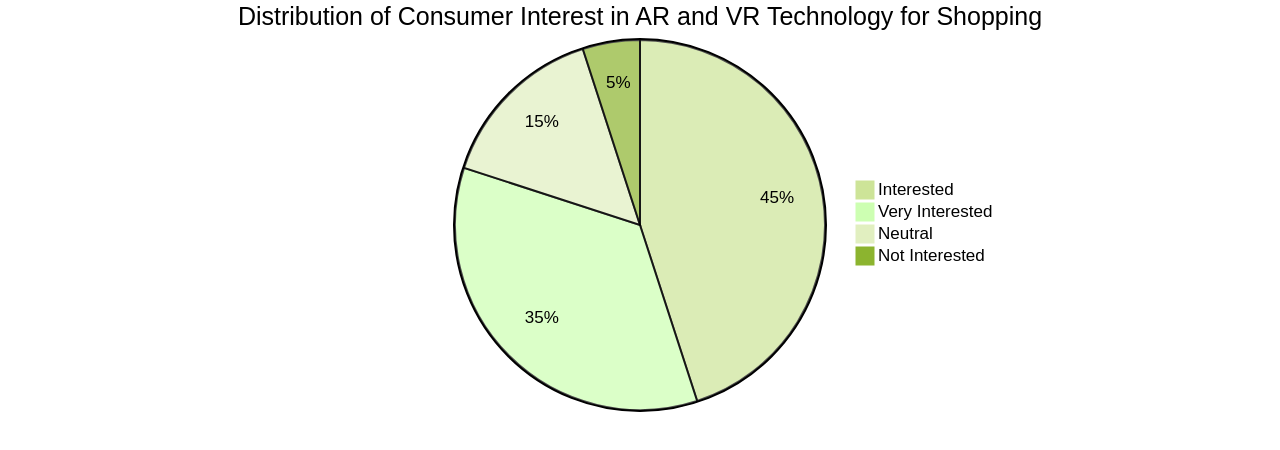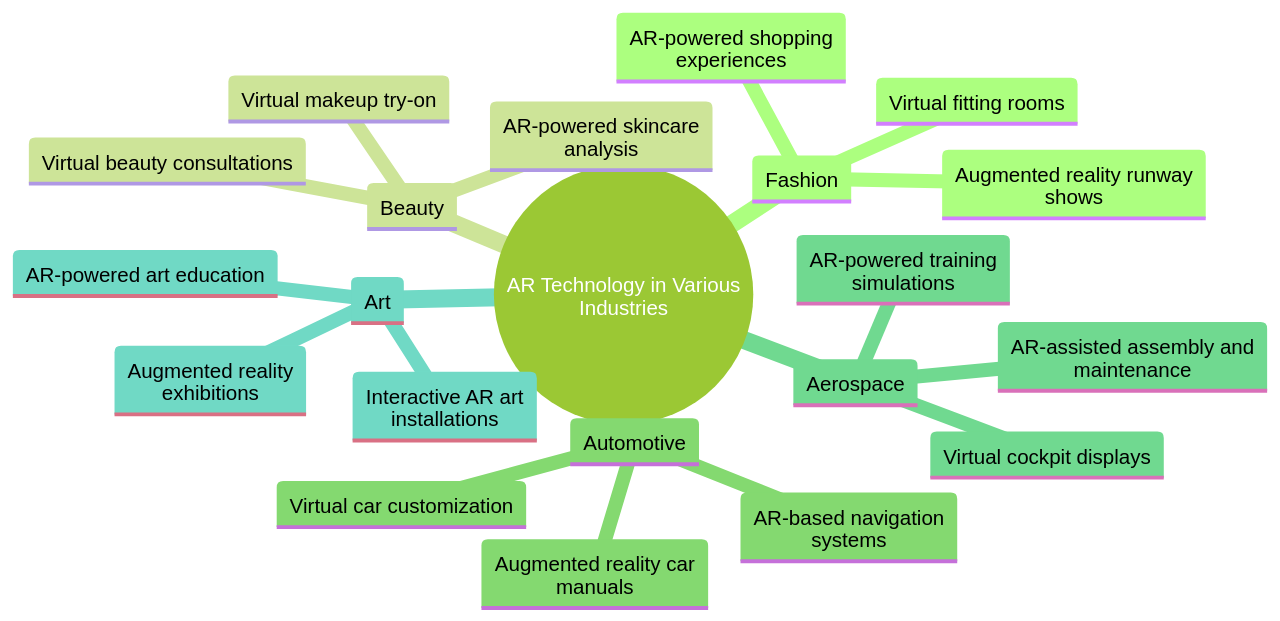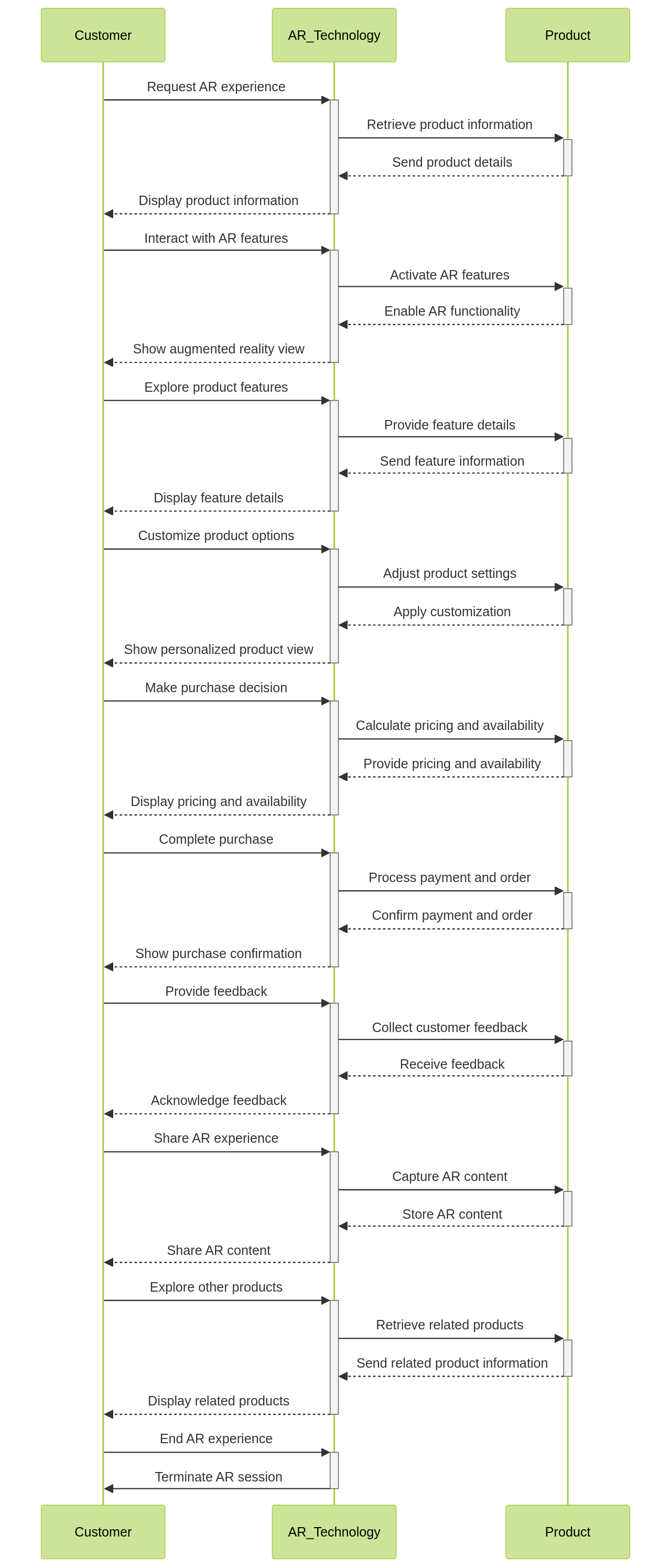Introduction
Augmented Reality (AR) is revolutionizing the e-commerce industry, offering customers a more immersive and engaging shopping experience. By projecting products into customers' personal space, AR enables them to make well-informed purchasing decisions and enhances customer satisfaction. From fashion retailers to furniture stores, businesses are integrating AR into their operations to elevate the customer experience and drive growth.
In this article, we will explore the rise of AR in e-commerce and its impact on product demonstrations and online sales. We will examine successful case studies in industries such as automotive and aerospace, where AR has transformed customer interactions and improved service efficiency. Additionally, we will discuss the challenges businesses face in implementing AR and how they can overcome them to create compelling AR experiences. By harnessing the power of AR, businesses can enhance customer engagement, increase conversion rates, and stay ahead in the ever-evolving e-commerce landscape.
1. The Rise of Augmented Reality in E-commerce
Augmented Reality (AR) is truly a force to be reckoned with in the e-commerce sphere. It has transformed the way customers interact with products, offering a more immersive, interactive, and engaging shopping journey. AR's unique capability to project products within a customer's personal space has proven invaluable in making well-informed purchasing decisions, as observed in various e-commerce businesses. This includes fashion retailers, furniture stores, and beauty brands, who have integrated AR into their operations to enhance customer experience.
The AR revolution is not just confined to marketing and sales. It has infiltrated various aspects of the shopping experience, including product trials. The virtual try-on feature, popular in the fashion and beauty sectors, has enabled customers to test products virtually, elevating the shopping experience.
AR's popularity in e-commerce is on the rise, with an expected market value of over $250 billion by 2028. This is testament to the growing trust and interest consumers have in AR technology. A recent survey shows that nearly half of the respondents are eager to use AR and VR technology for shopping in the next five years.

AR technology's application extends beyond conventional methods. Social media platforms like Snapchat and Instagram have aided brands in creating AR filters for their products. Furthermore, advancements in AR hardware, including improved smartphone cameras and smart glasses, have made AR shopping more accessible to the general public.
AR's use is not restricted to the online sphere.

Emerging trends in retail such as AR mirrors and the gamification of in-store shopping experiences are proof of this technology's versatility.
Amazon and Shopify are two notable pioneers in AR shopping apps. Amazon's "see it in your room" feature for larger home-based products and Shopify's provision for businesses to display their products using 3D assets and videos are prime examples of leveraging AR to enhance the shopping experience.
Yet, the implementation of AR in e-commerce platforms is not without its challenges. Ensuring a seamless integration of the technology with the platform and providing a user-friendly experience requires a robust backend infrastructure. The need for high-quality 3D models and assets, and addressing privacy and security concerns are also significant challenges. However, these can be overcome by partnering with experienced software developers, designers, and engineers who specialize in AR. They can provide the necessary expertise and develop custom solutions that meet the specific needs of the e-commerce business.
AR shopping, though still in its early stage, holds immense potential to become a mainstream aspect of e-commerce in the future. As more businesses recognize its capacity to elevate customer engagement and conversion rates, the adoption and application of AR in e-commerce are set to escalate exponentially.
2. Case Study: Successful AR Projects in the Automotive and Aerospace Industries
Augmented Reality (AR) technology is transforming industries, notably the automotive and aerospace sectors. With AR, Mercedes Benz has revolutionized the owner's manual.

Their "Ask Mercedes" application, powered by the Vuforia Engine, uses AR to overlay relevant information on a 3D model of the car's dashboard. This interactive guide simplifies understanding complex vehicle features, benefiting not just customers, but also dealership sales associates.
The aerospace sector, too, is leveraging AR. Cannondale, in partnership with PTC, uses AR to enhance customer experience and differentiate from competitors. AR provides a virtual experience that allows customers to interact with aerospace products in a realistic manner. This is particularly useful for demonstrating complex systems and components, enhancing the customer's understanding of the product.
BestToolbars offers custom web and mobile app development solutions for AR in these industries. Their team of developers, designers, and engineers work together to create innovative solutions tailored to client needs. Their services include market testing, MVP product launch, bug fixes, market alignment, and full outsourcing. They also offer flexible and cost-effective options, including on-demand contractors, to speed up development and test hypotheses.
AR technology can also be utilized for virtual car model "try on." Working with software developers, designers, and engineers who specialize in crafting innovative solutions can help develop an AR application that allows users to virtually try on different car models. Integrating this solution with existing teams can provide quick proof of concept, bug fixes, and market alignment, along with access to top-tier talent on a flexible, cost-effective basis through consulting services.
The Besttoolbars team, including CEO Oleg Grebenyuk, COO Nik Gavrilov, VP of Sales Tom Straszewski, and Head of Product Chris Ashbaugh, is available for one-on-one consultations. Whether you need full outsourcing or an integrated approach with your existing team, they can assist with quick proof-of-concept, initial project research, bug fixes, and market alignment.
Overall, AR technology is playing a pivotal role in enhancing customer satisfaction and streamlining operations in both the automotive and aerospace industries. Companies like Mercedes Benz, Cannondale, and BestToolbars are leading the way in harnessing the power of AR to create immersive product demonstrations that drive customer engagement and sales.
3. How AR Enhances Product Demonstrations and Boosts Online Sales
Augmented reality (AR) has emerged as a pivotal tool in enhancing the quality of product demonstrations in e-commerce, by creating immersive and engaging experiences for consumers. AR's transformative potential lies in its ability to allow consumers to visualize products within their own environment, which fosters a deeper understanding of how a product might fit into their lives, and subsequently, increases the likelihood of a purchase.
The art platform, BAM, successfully utilized AR to aid buyers in visualizing how a piece of art would look on their walls before making a purchase. By developing an AR application, BAM allowed potential buyers to project a model of a painting onto their walls through their phone or tablet screen. This innovative approach led to a significant increase in artwork sales and conversion rates, with the app receiving media features and over 1,000 downloads in its first week.
Likewise, Cannondale, a leading bicycle manufacturer, leveraged AR technology in partnership with PTC to enhance their customer experience. This strategic move enabled Cannondale to differentiate themselves from competitors, improve service efficiency, and showcase their products in a virtual environment. Customers were able to interact with the bikes and visualize them before making a purchase, which not only improved the buying experience but also streamlined service processes, reducing costs and enhancing efficiency.
These examples illustrate how AR-enhanced product demonstrations can increase customer engagement, reduce return rates, and enhance the overall shopping experience. AR technology can be used to provide interactive and immersive experiences such as virtual try-on for clothing and accessories, virtual furniture placement for home decor, and virtual room visualization for paint and wallpaper products.
However, the implementation of AR for product visualization requires a harmonious collaboration between software developers, designers, and engineers. This is where companies like BestToolbars come into play. They offer packages for testing market fit and consulting services to help launch a Minimum Viable Product (MVP). They provide access to top-tier talent, including developers, designers, and QA professionals, who can be integrated into an existing team for quick proof of concept, initial project research, bug fixes, market alignment, or full outsourcing.
Incorporating AR technology into the e-commerce platform can enhance customer engagement, increase sales conversion rates, and improve customer satisfaction. AR allows customers to visualize products in their own environment, helping them make more informed purchasing decisions. Additionally, AR can reduce the need for physical product samples, saving costs and improving convenience for both customers and businesses.
Implementing AR in e-commerce businesses, however, requires a clear understanding of specific goals and how AR can enhance the customer experience. It is crucial to invest in high-quality 3D models and assets that accurately represent products. This ensures that the AR experience is realistic and visually appealing, which can significantly impact customer engagement and satisfaction.
Overall, AR in e-commerce product demonstrations can be a game-changer, revolutionizing e-commerce experiences by enhancing product demonstrations and boosting online sales.
4. Overcoming Challenges in Implementing AR for E-commerce Businesses
Augmented Reality (AR) has been a powerful tool in the e-commerce industry, although it's not without its complications. These can range from technical issues such as device and operating system compatibility to user experience difficulties in creating an AR interface that is easy to use and navigate.
Saatchi Art, for instance, incorporated a web-based AR feature, "View in My Room", on its platform. This feature allows customers to visualize over a million works of art in their homes, using their smartphones or tablets without the need for an app. This AR feature was designed to address a common concern among art buyers who were hesitant to purchase due to their inability to preview the artwork. As a result, this feature led to a 17% average increase in spending.
The AR feature was developed by Rock Paper Reality (RPR), an AR agency, and is known as one of the largest deployments of web AR on the 8th Wall platform. The AR experience was improved with a proximity indicator to warn users when they are getting too close to the wall, demonstrating how intuitive and easy-to-use AR experiences can enhance the user experience.
Interestingly, the "View in My Room" feature has significantly increased conversion rates, with users who engaged with the feature being four times more likely to make a purchase compared to those who did not.
Samsung also created an AR shopping experience for its Latin America online store, in collaboration with Lift Studios. The aim was to develop an AR experience that didn't require an app and could be accessed with a single click. The team designed custom call-to-actions that aligned with Samsung's brand guidelines, created over 200 3D products that could be sized and rendered to the actual dimensions of the products. They also developed a custom CMS to manage products in the AR environment, utilizing both ARKit and ARCore to ensure compatibility with Android and iOS devices. This resulted in a groundbreaking AR experience that pushed the limits of e-commerce AR.
These examples highlight the transformative potential of AR in e-commerce, but they also emphasize the importance of careful planning and execution to overcome the challenges associated with implementing this technology.
Companies like Besttoolbars offer software development, design, and engineering solutions to overcome these challenges. Their team of experts, including Oleg Grebenyuk (CEO), Nik Gavrilov (COO), Tom Straszewski (VP of Sales), and Chris Ashbaugh (Head of Product), provide services such as market fit testing, consulting, and full outsourcing. With their expertise in AR implementation, they are capable of addressing technical challenges and crafting solutions specific to the needs of their clients.
The key to successful AR implementation lies in understanding the specific needs of the business, setting clear goals, and working closely with experienced AR agencies like Besttoolbars to create tailored solutions that enhance the customer experience and drive business growth.
5. Future Trends: The Potential of AR in Revolutionizing E-commerce Experiences
Augmented Reality (AR) is undoubtedly a game-changer in the e-commerce landscape. The potential for more realistic and engaging AR experiences, coupled with advancements in technologies like Artificial Intelligence (AI) and machine learning, points towards a future where shopping experiences are tailor-made and captivating. This transformative power of AR is already being harnessed by successful brands like Nike, H&M, and IKEA, setting the stage for others to follow suit.
In the e-commerce world, AR offers a solution to the challenge of customers not being able to physically interact with products before purchase. By overlaying computer-generated images and text onto real-world objects, AR provides customers with an immersive shopping experience. This can be experienced through mobile devices, which offer a 3D projection of the environment, allowing customers to interact with products before making a purchase decision.
Consider, for instance, the ability to try on virtual clothes or visualize paint colors on walls. Brands can also gather valuable consumer behavior data and preferences through AR, allowing for dynamically generated and interactive ad content, and offering a higher level of personalization and immersion.
The software developers, designers, and engineers at besttoolbars.net are well-equipped to provide innovative solutions and expertise in integrating AR technology, AI, and machine learning within the e-commerce industry. They can provide services ranging from consulting and testing to full outsourcing, offering flexible solutions to fit specific needs.
To maximize the impact of AR in personalized shopping experiences, there are several best practices to follow. The AR technology should integrate seamlessly with the shopping platform, ensuring a smooth and immersive user experience. Personalization is key, with AR experiences tailored to individual customer preferences and shopping history.
Performance optimization is also crucial, minimizing latency and providing a real-time interactive experience. Continuous customer feedback and iteration on AR implementation can further enhance the shopping experience and drive customer engagement.
AR's potential to revolutionize e-commerce experiences is significant. Customers get a more immersive and interactive shopping experience, with the ability to visualize products in their real environment before buying. This not only increases customer satisfaction but also reduces returns.
Furthermore, personalized product recommendations and virtual try-on features enable customers to make more informed purchasing decisions. By integrating AR solutions into the e-commerce platform, businesses can differentiate themselves from competitors and build long-lasting customer relationships.
When designing AR experiences in e-commerce, user-centric design, clear call-to-action, realistic rendering, performance optimization, contextual integration, and continuous user feedback and testing are vital. By following these best practices, e-commerce businesses can create compelling and immersive AR experiences that enhance the shopping process and drive customer engagement.
The future of AR in e-commerce is promising. Brands that invest early in AR and find innovative ways to incorporate it into the retail experience will outpace competitors and offer superior customer experiences. The digital revolution is here, and businesses that leverage AR technology will be at the forefront.
Conclusion
The rise of Augmented Reality (AR) in e-commerce has revolutionized the way customers interact with products, providing a more immersive and engaging shopping experience. By projecting products into customers' personal space, AR enables them to make well-informed purchasing decisions and enhances customer satisfaction. From fashion retailers to furniture stores, businesses are integrating AR into their operations to elevate the customer experience and drive growth.
AR has transformed product demonstrations in industries such as automotive and aerospace, allowing customers to interact with complex systems and components virtually. Successful case studies from Mercedes Benz and Cannondale demonstrate how AR has improved customer interactions, increased sales conversion rates, and streamlined service processes. The implementation of AR in e-commerce platforms does come with challenges, such as backend infrastructure requirements and addressing privacy and security concerns. However, by partnering with experienced software developers, designers, and engineers who specialize in AR, businesses can overcome these challenges and create compelling AR experiences.
In conclusion, the rise of AR in e-commerce offers immense potential for enhancing customer engagement, increasing conversion rates, and staying ahead in the ever-evolving digital landscape. By harnessing the power of AR technology and leveraging successful case studies from industries like automotive and aerospace, businesses can create immersive product demonstrations that drive customer satisfaction and boost online sales. To unlock these benefits, businesses should partner with experienced professionals who can provide expertise in implementing AR solutions tailored to their specific needs.





